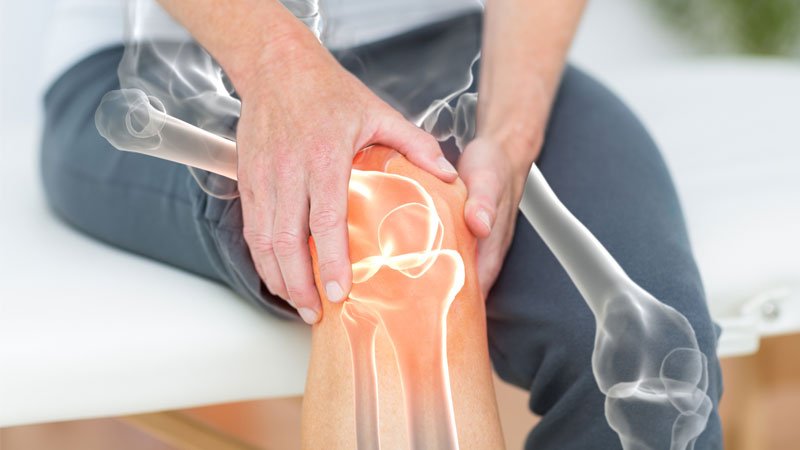Rheumatism is an umbrella term for conditions causing chronic, sometimes sporadic pain, in which connective tissue and joints are affected. Although there are at least 200 different conditions including: Lupus, Ankylosing spondylitis (AS), Psoriatic arthritis (PsA), Gout and Polymyalgia rheumatica, this article will focus on two of the most common disorders: Osteoarthritis and Rheumatoid arthritis.
Osteoarthritis is a degenerative joint disease and is the most common form of arthritis. It affects the smooth part of the cartilage attached to the ends of bones in order to help joints articulate more easily. It also affects the ends of the bones, the membrane that encapsulates the joint, and muscles next to the joint. Osteoarthritis dries out the protective and lubricating properties of the cartilage which in turn starts to soften and crack. As a result, abnormal bone hardening can occur in the body”s effort to repair itself, fluid can build up in pockets around the affected bone, and as the cartilage wears away, the bones rub together causing pain, stiffness and inflammation. Toxins, such as uric acid may be a contributory factor in arthritis. Uric acid is deposited as crystals in joint spaces, causing inflammation, pain, stiffness, loss of mobility and eventually disease to the joint surfaces. Factors such as stress and anxiety reduce our ability to deal with toxic wastes while poor nutrition and environmental pollution puts our bodies under additional pressure to eliminate toxins.
Rheumatoid Arthritis is the most common arthritic disease after osteoarthritis and usually affects the hands, wrists and feet. It is an auto-immune disorder which means the immune system – which normally fights infection – attacks the cells that line the joints by mistake, causing pain, stiffness and swelling. Persistent inflammation over time can damage the joint, cartilage and neighbouring bone. Rheumatoid arthritis is about three times more common in women than men!
Joint pain
One of the main symptoms of Osteoarthritis or Rheumatoid Arthritis is joint pain. Pain is felt as a result of the brain’s response to neural and hormonal changes in the body as a result of damage, disease or injury. Signals from damage or injury are picked up by sensory receptors in nerve endings. The nerves then transmit the signal via the nerves leading from the injury to the spinal cord, then into the brain where the signal is interpreted as pain. Pain can be regarded as a self-protective mechanism which stops us from continuing to use the injured part and ensuring we rest it.
Conventional treatments for rheumatism
People are often prescribed various anti-inflammatory medication, pain killers or steroids for osteoarthritis and rheumatoid arthritis. Pain killers such as ibuprofen and aspirin are also anti-inflammatory and will help mask the pain as well as help to reduce inflammation. They are not without side-effects however and can result in stomach irritation, and long-term use of steroids can decrease the body’s own natural immunity.
Exercise and rheumatism
Gentle exercises can help reduce arthritis symptoms and may even control its progression by strengthening muscles that support arthritic joints and increasing range of motion of the joints. Exercise can also help in weight control, which puts less strain on load bearing joints. This is supported by a number of scientific studies including a randomised control trial, in which twenty-eight patients with established, controlled RA were randomised to either 24 weeks of twice-weekly high-intensity progressive resistance training (PRT) or a range of movement home exercise control group. Results indicated that PRT proved safe and effective in restoring lean mass and function in patients with RA (Lemmey, et al., 2009). Medical advice should be obtained before undertaking an an exercise regime.
How aromatherapy can help with rheumatism
While aromatherapy cannot cure osteoarthritis or rheumatoid arthritis there are many essential oils and carrier oils that can help slow down its progress by preparing the body for exercise and aiding recovery from exercise, easing anxiety and promoting relaxation, supporting detoxification and last but not least reducing pain and inflammation. We discuss the most common methods of application and suitable essential oils below.
Aromatherapy massage
When a child falls over, they are often told to ‘rub it better’, and this is something that we sometimes do as adults. For some reason, this action seems to reduce the pain, and this is possibly because our nerve pathways are being stimulated to interrupt the pain signal to the brain, sometimes referred to as the pain gate mechanism. The same theory may be applied to aromatherapy massage in which the affected area is ‘rubbed’ using massage techniques, such as gentle effleurage and petrissage. However, it is important to note that pain indicates damage, so massaging inflamed sites should be done with care. Massage may provide short-term relief from pain because there is also an increase of endorphins released into the blood-stream as a result of the stimulation and these hormones are natural pain killers. If you wish to have an aromatherapy massage, we recommend that you visit either the International Federation of Aromatherapists or The Federation of Holistic Therapists websites to find a suitably qualified therapist in your area. Other methods can be used relatively easily, however, within the home environment and are described in some detail below.
Aromatherapy baths
Add 5 drops of essential oil or a mix of essential oils to 1 cup of Epsom Salt and pour into warm (not hot) running bath water. Relax for approximately 20 minutes. This method is particularly good for reducing pain and aiding relaxation.
Clay poultices
Make a stiff paste by adding water to 1 tablespoon of Ultra Fine French Green Clay. Add up to seven drops of essential oil from the lists below and mix well (you may need to make up more mixture if applying to a larger area). Smear the mixture over the affected joints and painful areas, cover with muslin and rest. Follow this procedure twice a day. If hot water is used, it can be helpful for removing toxins, whilst cold water may help reduce inflammation.
Hot and cold compresses
To make a hot compress, take about 100ml of hot water, as warm as can be tolerated comfortably, and add between five to six drops of appropriate essential oils. Place a folded piece of material on top of the water and let it soak. Next wring out the excess water and place the cloth over the area to be treated. The warm compress may be covered with cling film and a towel placed on top. The compress should be replaced with a new compress as soon as it has cooled to body temperature. This method can help reduce pain*.
A cold compress is made exactly the same as the hot compress, but iced or refrigerated water is used instead of hot water, and the compress is replaced when it has warmed up to body temperature – in any event, a cold compress should not be left on the affected area for more than 10 minutes. This method can help reduce inflammation.
Inhalation
Essential oils can be used very simply throughout the day either by diffusing few drops of the chosen oil(s) in a candle burner or diffuser, or by placing a couple of drops of oil on a tissue or in an aromatherapy inhaler and sniffing as required.
Essential oils for Osteo and Rheumatoid Arthritis
Although there are many useful essential oils, here are some of the most popular choices along with a recommended blend for pain relief.
Detoxifying essential oils
These may help remove toxins and can be effective for post exercise recovery. Recommended methods of use: Compresses, Bathing, Massage.
- Cypress
- Fennel
- Juniperberry
- Lemon
Analgesic essential oils
These oils help reduce pain and may also be used after exercise. Recommended methods of use: Compresses, Bathing, Massage.
- Lavender
- Chamomile (Roman/German)
- Benzoin
- Rosemary
Rubefacient essential oils
These oils produce redness of the skin, which is caused by blood capillary dilation and an increase in blood circulation, giving a soothing feeling of warmth*. Rubefacient oils can be used for reducing pain and preparing for exercise. Recommended methods of use: Compresses, Bathing, Massage.
Relaxing essential oils
These oils help promote a sense of wellbeing and may reduce anxiety and improve mood. Recommended methods of use: Bathing, Massage, Inhalation.
Recommended aromatherapy blend for joint pain
Apply to the affected area(s) twice a day.
* NOTE: Whenever heat is applied to a painful, stiffened joint it is very important to move the joint immediately afterwards, otherwise the heating can cause congestion which will make the condition worse rather than better.
Christine Fisk
Consultant Aromatherapist
Disclaimer & Safety Advice
Read other articles by Christine Fisk
References
- Lemmey, A., Marcora, S., Chester, K., S, W., Casanova, F., & Maddison, P. (2009). Effects of high-intensity resistance training in patients with rheumatoid arthritis: a randomized controlled trial. Arthritis Care and Research, 61(12), 1726-34. doi:https://doi.org/10.1002/art.24891.

